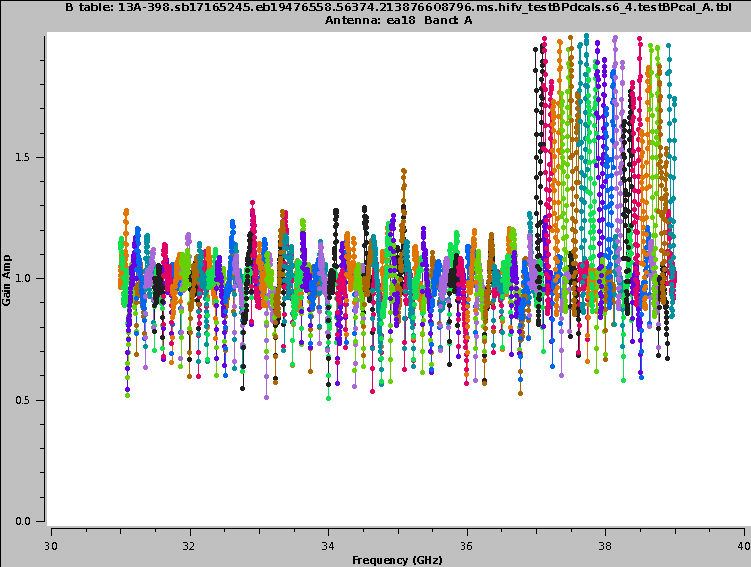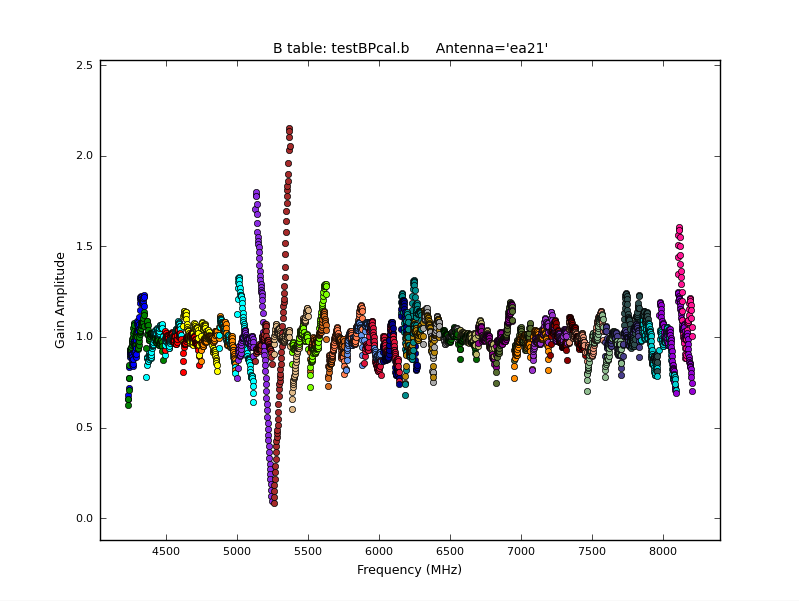Pipeline: Frequent VLA problems: Difference between revisions
Created page with "General Description The VLA pipeline delivers calibrated data and some initial images of VLA observation runs. The quality of the calibration and imaging products is usually a..." |
No edit summary |
||
| Line 10: | Line 10: | ||
RFI | RFI | ||
Deformatter Problems | Deformatter Problems | ||
The digital transmission system (''DTS'') of each VLA antenna includes a formatting stage to convert the electronic to an optical signal before it is injected on the optical fiber link. On the correlator end the signal will be deformatted back to an electronic signal. Occasionally, the timing on the deformatter can be misaligned which results in very strong amplitude or phase slopes as a function of frequency. Sometimes the signal is similar to an ''abs(sin)'', or a 'bouncing' signal across a baseband for one polarization. The stage 6 tries to identify such deformatter errors by checking for deviations more than 15% over the average bandpass. If more than 4 spws of a baseband are affected this way, the entire baseband will be flagged. | |||
For our data, no deformatter issues were automatically detected in the data (see the tables in the bottom of the main page (Fig. 15, bottom). We did see, however, that ea18 has a DTS problem in the 37-39GHz baseband (Figs. 19b/21a and 20c). Since this stage 6 did not detect and flag this range (which shows the limitations of the underlying code), manual flagging will be required for the affected antenna, polarization, and baseband for all sources. An example from a different dataset is provided in Fig. 21b. The 'V' shape close to 5.3 GHz with some values reaching close to zero are a sign for a deformatter problem. | |||
{| | |||
|[[Image:VLApipe-step6-BPgain-ea18-CASA6.2.1.png|400px|thumb|left|Fig. 21a: Same as 19b, ea18 which shows a digital transmission issue that ''hifv_flagbaddef'' was not able to identify.]] | |||
|[[Image:VLApipe-baddefromatterexampleBP.png|400px|thumb|left|Fig. 21b: An example of a bad deformatter from a different dataset.]] | |||
|} | |||
Revision as of 00:36, 15 December 2021
General Description The VLA pipeline delivers calibrated data and some initial images of VLA observation runs. The quality of the calibration and imaging products is usually assessed through the weblog that is created in each pipeline run. During the observations, the VLA may have encountered technical problems that are reflected in various ways in the weblog, analytic graphs show the behavior of the calibration tables as a function of time, frequency, polarization, etc. Analytical numbers describe the amount of flagging, derived fluxes, image statistics, etc.
Here we would like to briefly describe common VLA observing problems, how they are identified in the pipeline calibration weblog, and how they can be addressed.
Pointing
RFI
Deformatter Problems
The digital transmission system (DTS) of each VLA antenna includes a formatting stage to convert the electronic to an optical signal before it is injected on the optical fiber link. On the correlator end the signal will be deformatted back to an electronic signal. Occasionally, the timing on the deformatter can be misaligned which results in very strong amplitude or phase slopes as a function of frequency. Sometimes the signal is similar to an abs(sin), or a 'bouncing' signal across a baseband for one polarization. The stage 6 tries to identify such deformatter errors by checking for deviations more than 15% over the average bandpass. If more than 4 spws of a baseband are affected this way, the entire baseband will be flagged.
For our data, no deformatter issues were automatically detected in the data (see the tables in the bottom of the main page (Fig. 15, bottom). We did see, however, that ea18 has a DTS problem in the 37-39GHz baseband (Figs. 19b/21a and 20c). Since this stage 6 did not detect and flag this range (which shows the limitations of the underlying code), manual flagging will be required for the affected antenna, polarization, and baseband for all sources. An example from a different dataset is provided in Fig. 21b. The 'V' shape close to 5.3 GHz with some values reaching close to zero are a sign for a deformatter problem.
 |
 |
Correlator Zeros
Baseband and Subband Edges
Compression
Resolved Calibrators
Wrong Intents
Extreme Solution Intervals
Weather
Decorrelation
Shadowing
Switches